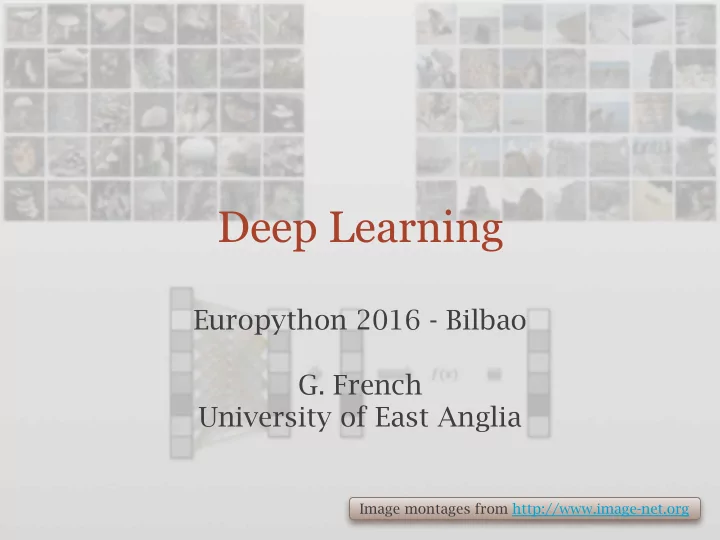

after 300 iterations over training set: 99.21% validation accuracy Model Error FC64 2.85% FC256--FC256 1.83% 20C5--MP2--50C5--MP2--FC256 0.79%
What about the learned kernels? Image taken from paper [Krizhevsky12] Gabor filters (ImageNet dataset, not MNIST)
Image taken from [Zeiler14]
Image taken from [Zeiler14]
Lasagne
Specifying your network as mathematical expressions is powerful but low-level
Lasagne is a neural network library built on Theano Makes building networks with Theano much easier
Provides API for: constructing layers of a network getting Theano expressions representing output, loss, etc.
Lasagne is quite a thin layer on top of Theano, so understanding Theano is helpful On the plus side, implementing custom layers, loss functions, etc is quite doable.
Intro to Theano and Lasagne slides: https://speakerdeck.com/britefury https://speakerdeck.com/britefury/intro-to-theano-and-lasagne-for-deep-learning
Notes for building and training neural networks
Neural network architecture (OxfordNet / VGG style)
Early part # Layer Input: 3 x 224 x 224 (RGB image, zero-mean) Blocks consisting of: 1 64C3 2 64C3 MP2 A few convolutional layers, often 3x3 3 128C3 kernels 4 128C3 - followed by - MP2 Down-sampling; max-pooling or 64C3 = 3x3 conv, 64 filters MP2 = max-pooling, 2x2 striding
# Layer Notation: Input: 3 x 224 x 224 (RGB image, zero-mean) 64C3 1 64C3 convolutional 2 64C3 layer with 64 3x3 MP2 filters 3 128C3 4 128C3 MP2 MP2 max-pooling, 2x2
# Layer Input: 3 x 224 x 224 (RGB image, zero-mean) Note 1 64 C3 2 64 C3 after down- MP2 sampling, double the number of 3 128 C3 4 128 C3 convolutional MP2 filters
# Layer Later part: Input: 3 x 224 x 224 (RGB image, zero-mean) After blocks of 1 64C3 convolutional and 2 64C3 down-sampling MP2 layers: 3 128C3 4 128C3 Fully-connected MP2 (a.k.a. dense) FC256 layers FC10
# Layer Input: 3 x 224 x 224 (RGB image, zero-mean) Notation: 1 64C3 2 64C3 FC256 MP2 fully-connected 3 128C3 layer with 256 4 128C3 channels MP2 FC256 FC10
# Layer Input: 3 x 224 x 224 Overall (RGB image, zero-mean) 1 64C3 Convolutional 2 64C3 layers detect MP2 feature in various 3 128C3 positions 4 128C3 throughout the MP2 image FC256 FC10
# Layer Input: 3 x 224 x 224 Overall (RGB image, zero-mean) 1 64C3 Fully-connected / 2 64C3 dense layers use MP2 features detected 3 128C3 by convolutional 4 128C3 layers to produce MP2 output FC256 FC10
Could also look at architectures developed by others, e.g. Inception by Google, or ResNets by Micrsoft for inspiration
Batch normalization
Batch normalization [Ioffe15] is recommended in most cases Necessary for deeper networks (> 8 layers)
Recommend
More recommend